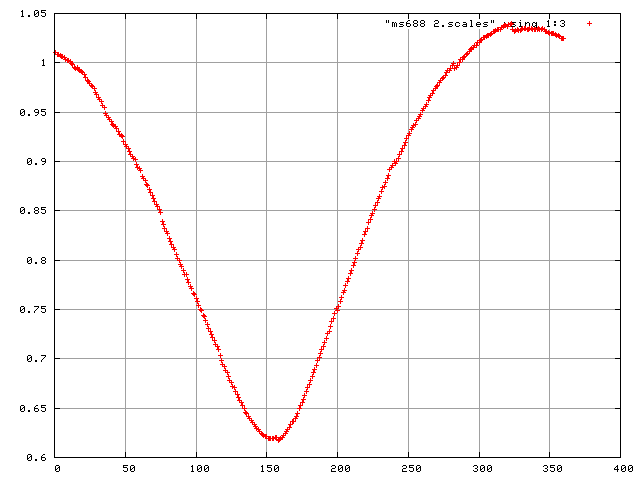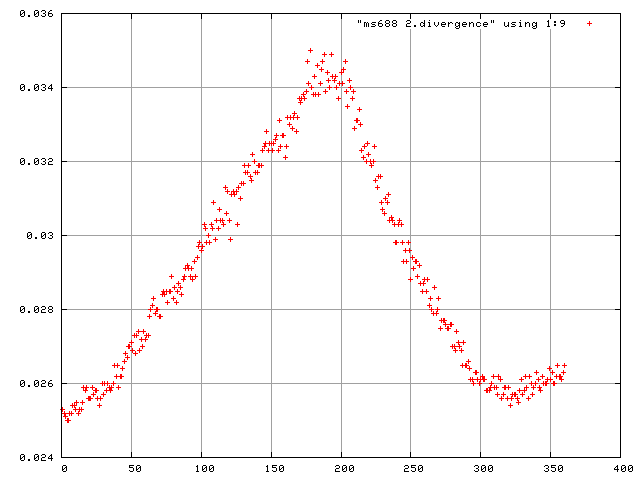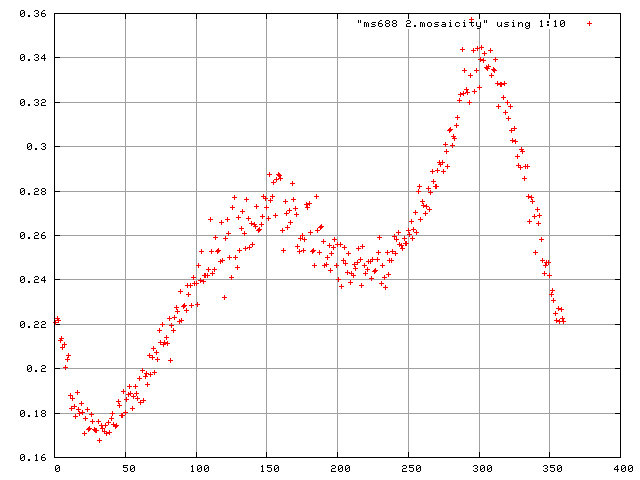Jiffies: Difference between revisions
mNo edit summary |
No edit summary |
||
| (13 intermediate revisions by 3 users not shown) | |||
| Line 1: | Line 1: | ||
Here | Here is a one-liner for your .cshrc : | ||
alias | alias scalefactors "egrep '^ ..... ..[0-9] ...... ........ .... ...... ....... ..... ........ ........' INTEGRATE.LP" | ||
In sh/bash/ksh/zsh syntax the latter would be: | |||
alias scalefactors="egrep '^ ..... ..[0-9] ...... ........ .... ...... ....... ..... ........ ........' INTEGRATE.LP" | |||
which could go into ~/.bashrc (or should it go into .login or .profile?) | |||
---- | |||
''scalefactors'' finds those lines in INTEGRATE.LP which match a certain pattern of blanks and non-blanks. These are just the lines printed during the INTEGRATE step for each frame. It is very useful (e.g. to find shutter problems, or to "see" the crystal die from radiation damage) to run | ''scalefactors'' finds those lines in INTEGRATE.LP which match a certain pattern of blanks and non-blanks. These are just the lines printed during the INTEGRATE step for each frame. It is very useful (e.g. to find shutter problems, or to "see" the crystal die from radiation damage) to run | ||
scalefactors > frames.scales | scalefactors > frames.scales | ||
and to plot the scale factors | and to plot the scale factors, mosaicity and beam divergence of each frame in gnuplot. | ||
This can be done by | This can be done by | ||
| Line 28: | Line 28: | ||
If you do have bad outliers (e.g. shutter didn't open), and decide that you for now simply want to remove those frames, then you could rename the frames (just append ".bad" to the name), and re-run XDS from the INTEGRATE step. | If you do have bad outliers (e.g. shutter didn't open), and decide that you for now simply want to remove those frames, then you could rename the frames (just append ".bad" to the name), and re-run XDS from the INTEGRATE step. | ||
* Please note that mosaicity is the unrefined mosaicity. The refined mosaicity values for each integrated batch (nine values for different regions on the detector) can be found in the lines containing the string "SIGMAR (degrees)". | |||
---- | |||
If you simply want the plots and glue them into your lab book, just run (assuming "ms688_2" is the name of your dataset!): | |||
#!/bin/csh -f | |||
setenv DATASET ms688_2 | |||
scalefactors > $DATASET.scales | |||
ln -s $DATASET.scales $DATASET.mosaicity | |||
ln -s $DATASET.scales $DATASET.divergence | |||
gnuplot<<EOF | gnuplot<<EOF | ||
set term png | set term png | ||
set grid | set grid | ||
set out 'scale.png' | set out 'scale.png' | ||
plot " | plot "$DATASET.scales" using 1:3 | ||
set out 'divergence.png' | set out 'divergence.png' | ||
plot " | plot "$DATASET.divergence" using 1:9 | ||
set out 'mosaicity.png' | set out 'mosaicity.png' | ||
plot " | plot "$DATASET.mosaicity" using 1:10 | ||
EOF | EOF | ||
rm -f $DATASET.{scales,mosaicity,divergence} | |||
to get | |||
[[Image:scale.gif]] | |||
[[Image:divergence.gif]] | |||
[[Image:mosaicity.gif]] | |||
Latest revision as of 14:47, 3 July 2019
Here is a one-liner for your .cshrc :
alias scalefactors "egrep '^ ..... ..[0-9] ...... ........ .... ...... ....... ..... ........ ........' INTEGRATE.LP"
In sh/bash/ksh/zsh syntax the latter would be:
alias scalefactors="egrep '^ ..... ..[0-9] ...... ........ .... ...... ....... ..... ........ ........' INTEGRATE.LP"
which could go into ~/.bashrc (or should it go into .login or .profile?)
scalefactors finds those lines in INTEGRATE.LP which match a certain pattern of blanks and non-blanks. These are just the lines printed during the INTEGRATE step for each frame. It is very useful (e.g. to find shutter problems, or to "see" the crystal die from radiation damage) to run
scalefactors > frames.scales
and to plot the scale factors, mosaicity and beam divergence of each frame in gnuplot.
This can be done by
> gnuplot plot "frames.scales" using 1:3
or
> gnuplot plot "frames.scales" using 1:9
or
> gnuplot plot "frames.scales" using 1:10
It is useful to run gnuplot this way, because you can move the mouse over an outlier and see its coordinates (x=frame number) in the lower left corner of the plot window.
If you do have bad outliers (e.g. shutter didn't open), and decide that you for now simply want to remove those frames, then you could rename the frames (just append ".bad" to the name), and re-run XDS from the INTEGRATE step.
- Please note that mosaicity is the unrefined mosaicity. The refined mosaicity values for each integrated batch (nine values for different regions on the detector) can be found in the lines containing the string "SIGMAR (degrees)".
If you simply want the plots and glue them into your lab book, just run (assuming "ms688_2" is the name of your dataset!):
#!/bin/csh -f
setenv DATASET ms688_2
scalefactors > $DATASET.scales
ln -s $DATASET.scales $DATASET.mosaicity
ln -s $DATASET.scales $DATASET.divergence
gnuplot<<EOF
set term png
set grid
set out 'scale.png'
plot "$DATASET.scales" using 1:3
set out 'divergence.png'
plot "$DATASET.divergence" using 1:9
set out 'mosaicity.png'
plot "$DATASET.mosaicity" using 1:10
EOF
rm -f $DATASET.{scales,mosaicity,divergence}


